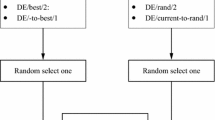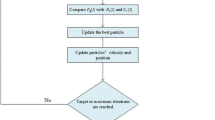Abstract
Flood classification is the fundamental problem of flood risk analysis and plays an important role in flood disaster risk management. Considering the fact that flood classification is a problem of multi-attribute and multi-stage fuzzy synthetically evaluation, this paper mainly proposed the weighted fuzzy kernel-clustering algorithm (WFKCA) with adaptive differential evolution algorithm (ADE) to solve this problem. Firstly, WFKCA is detailed introduced, and then the differential evolution algorithm (DE) is applied for the fuzzy clustering, thus to obtain the better results. Taking into consideration the disadvantage of DE, ADE is present after the introduction of DE. Finally, the combination of WFKCA and ADE is applied for flood classification, and the results demonstrated the methodology is reasonable and reliable, thus provide a new effective approach for flood classification.

Similar content being viewed by others
References
Anderberg M (1973) Cluster analysis for applications. Academic Press, New York
Bezdek JC (1974) Cluster validity with fuzzy sets. J Cybern 3:58–73
Bezdek JC (1981) Pattern recognition with fuzzy objective function algorithms. Plenum, New York
Chen SY, Guo Y (2006) Variable fuzzy sets and its application in comprehensive risk evaluation for flood-control engineering system. Fuzzy Optim Decis Making 5:153–162
Graves D, Pedrycz W (2010) Kernel-based fuzzy clustering and fuzzy clustering: a comparative experimental study. Fuzzy Sets Syst 161(4):522–543
Guan Y, Zhao SX (2009) Application of fuzzy clustering based on entropy weights in flood classification. J North China Inst Water Conserv Hydroelectr Power 30(4):9–11
He YY, Zhou JZ, Kou PG, Lu N, Zou Q (2011) A fuzzy clustering iterative model using chaotic differential evolution algorithm for evaluating flood disaster. Expert Syst Appl 38:10060–10065
Hu D, Sarosh A, Dong YF (2012) A novel KFCM based fault diagnosis method for unknown faults in satellite reaction wheels. ISA Trans 51(2):309–316
Huang DP, Zhang RH, Huo ZG, Mao F, Youhao EH (2012) An assessment of multidimensional flood vulnerability at the provincial scale in China based on the DEA method. Nat Hazards 64:1575–1586
Jain A, Dubes R (1988) Algorithms for clustering data. Prentice-Hall, Englewood Cliffs, NJ
Jin JL, Cheng L, Li YQ, et al (2009) Fuzzy clustering method based on set pair analysis and optimal fuzzy equivalent matrix for flood classification. In: Proceedings of 2009 Chinese Control and Decision Conference, pp 5923–5927
Jin JL, Wei YM, Zou LL, Li L, Fu J (2012) Risk evaluation of China’s natural disaster systems: an approach based on triangular fuzzy numbers and stochastic simulation. Nat Hazards 62(1):129–139
Kandilioti G, Makropoulos C (2012) Preliminary flood risk assessment: the case of Athens. Nat Hazards 61:441–468
Koloseni D, Lampinen J, Luukka P (2012) Optimized distance metrics for differential evolution based nearest prototype classifier. Expert Syst Appl 39(12):10564–10570
Liu YB, Liang C (2010) Watershed flood classification research based on PCP-C coupling model. J China Hydrol 30(1):18–22
Lu ZB, Hou ZC (2007) Cluster validity analysis for flood clustering. South North Water Trans Water Sci Technol 5(2):87–90
Lu YL, Zhou JZ, Qin H, Li YH, Zhang YC (2010) An adaptive hybrid differential evolution algorithm for dynamic economic dispatch with valve-point effects. Expert Syst Appl 37:4842–4849
Ni CJ, Cui P (2007) Projection pursuit dynamic cluster model. J Syst Eng 22(6):634–638
Plate EJ (2002) Flood risk and flood management. J Hydrol 267:2–11
Qian WY, Li AJ (2008) Adaptive differential evolution algorithm for multi objective optimization problems. Appl Math Comput 201:431–440
Ren ML, Wang BD (2009) Research on classified flood forecast based on fuzzy clustering and BP neural networks. J Dali Univ Technol 49(1):121–127
Shen HB, Yang J, Wang ST, Liu XJ (2006) Attribute weighted Mercer Kernel based fuzzy clustering algorithm for general non-spherical datasets. Soft Comput 10(11):1061–1073
Storn R, Price K (1997) Differential evolution-a simple and efficient Heuristic or global optimization over continuous spaces. J Global Optim 1:341–359
Swagatam D, Amit K (2009) Automatic image pixel clustering with an improved differential evolution. Appl Soft Comput 9(1):226–236
Swagatam D, Sudeshna S (2010) Kernel-induced fuzzy clustering of image pixels with an improved differential evolution algorithm. Information Sciences 1237–1256
Wu CG, Wang YM, Tang YM, Huang Q, Jin JL (2012) Variable fuzzy recognition model for the flood hazard assessment based on set pair analysis. J Northwest A&F Univ 40(1):221–226
Xie XL, Beni G (1991) A validity measure for fuzzy clustering. IEEE Trans Pattern Anal Mach Intell 3:841–846
Xu DM, Chen SY, Qiu L (2011) Study on flood classification based on variable fuzzy sets theory. Water Resour Power 29(1):23–25
Zhang DQ, Chen SC (2003) Clustering incomplete data using Kernel-based fuzzy C-means algorithm. Neural Process Lett 18(3):155–162
Zhang L, Da ZW, Jiao LC (2002) Kernel clustering algorithm. Chinese J Comput 25:587–590
Zhang XY, Zhou JZ, Wang CQ, Li CS, Song LX (2012) Multi-class support vector machine optimized by inter-cluster distance and self-adaptive deferential evolution. Appl Math Comput 218:4973–4987
Acknowledgments
This study is financially supported by the Special Research Foundation for the Public Welfare Industry of the Ministry of Water Resources (Grant No. 201001080), the State Key Program of National Natural Science of China (Grant No. 51239004) and the Research Fund for the Doctoral Program of Higher Education of China (Grant No. 20100142110012).
Author information
Authors and Affiliations
Corresponding author
Rights and permissions
About this article
Cite this article
Liao, L., Zhou, J. & Zou, Q. Weighted fuzzy kernel-clustering algorithm with adaptive differential evolution and its application on flood classification. Nat Hazards 69, 279–293 (2013). https://doi.org/10.1007/s11069-013-0707-x
Received:
Accepted:
Published:
Issue Date:
DOI: https://doi.org/10.1007/s11069-013-0707-x




